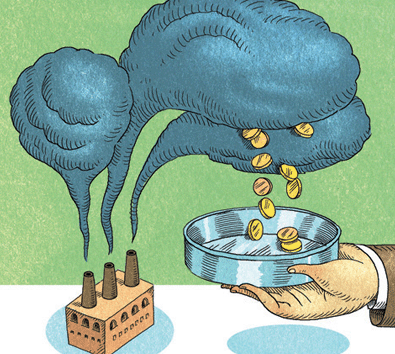The debate over the choice of policy instruments to control domestic emissions of carbon dioxide (CO2), the leading greenhouse gas, is not about the greater flexibility of market-based instruments over traditional forms of regulation (such as mandates for the adoption of emissions-saving technologies). In reality, it’s between two market-based alternatives, namely emissions taxes and cap-and-trade systems.
Each of these policy instruments puts a price on CO2 emissions, either directly under the tax, or indirectly through establishing a market price for pollution permits under the cap-and-trade approach. The price on emissions will encourage mitigation efforts across the economy, such as switching toward cleaner fuels in power generation, adoption of energy-saving technologies and conservation of conventional motor fuels.
However, CO2 taxes and cap-and-trade programs differ in one critically important regard. Carbon taxes directly raise revenue for the government while cap-and-trade systems, in their traditional form with free distribution of allowances to regulated firms, do not. For example, a $20 tax on CO2 emissions would raise revenues in the order of $100 billion in the near term.
Ideally, this revenue would be recycled back to the economy in the form of income tax reductions for households and firms. This would generate benefits to the broader economy through stimulating work effort, investment and savings and reducing distortions from tax preferences that encourage excessive spending on fringe benefits and home ownership. In fact, the economic efficiency gains from recycling carbon tax revenues would be very substantial, in the order of $25 billion a year or more.
Unfortunately, there is also a counteracting effect as higher energy prices drive up production costs and (slightly) contract overall economic activity, which tends to exacerbate the distortive effects of taxes on labor and capital markets. Nonetheless, the potential for revenue recycling to reduce the burden of the broader fiscal system is the key to containing the economy-wide costs of carbon reduction policies.
If the revenue-recycling benefit is foregone under cap-and-trade systems by giving away all the allowances for free, then the overall cost of the policy (for a comparable reduction in emissions) is dramatically larger than under the emissions tax. In fact, studies suggest that cap-and-trade systems may impose costs on the economy that are two or three times as large as those under emissions taxes.
Of course allowances could be auctioned off by the government, in which case a cap-and-trade system can generate government revenue similar to an emissions tax. In this regard, there might be little difference in overall costs under the two policy approaches. However, the prospects for allowance auctions do not look good in practice, if the main legislative proposal, the Waxman-Markey bill that was recently voted out of the House Energy and Commerce Committee, is anything to go by. Under this bill, some 85 percent of the permits over the next 20 years will be given away for free to firms.
Even if CO2 allowances were fully auctioned, arguably the prospects for efficient revenue use will be weaker than under an emissions tax. Revenues under a CO2 tax would be under the jurisdiction of tax committees in the House and Senate—and thus more directly reallocated in the federal budget. In contrast, under a cap-and-trade system, disbursement of revenues would likely also involve environmental and energy committees that might be predisposed to use revenues for other purposes, holding the risk that—with more actors involved—revenues would be earmarked for less efficient spending programs.
Even under an emissions tax, there is still the risk that revenues may not be used productively—in fact, more often than not, governments have used new revenue windfalls to expand public spending rather than reduce other taxes. To the extent that extra spending results from lobby-group pressure, it may produce little, if any, benefit to the overall economy. The devil is truly in the details: the case for an emissions tax hinges on accompanying legislation specifying efficient use of revenues, particularly offsetting reductions in other distortionary taxes.
Cap-and-trade systems currently seem to have greater political traction than emissions taxes. One reason: the higher energy prices that would be caused by emissions taxes may disproportionately hurt lower-income families who tend to spend a greater share of their budget on electricity and other energy goods. Cap-and-trade programs would also raise energy prices. However, specific provisions in the Waxman-Markey bill are designed to dampen this effect through granting free allowance allocations to local electricity distribution companies that limit price increases. This has the perverse effect of reducing incentives for energy conservation.
Emissions tax systems can also provide compensation to lower income families through reductions in their income tax burdens. Moreover, it is not immediately obvious why we should be so concerned about the potentially regressive effects of higher energy taxes. The central objective of climate policy should be to impose a progressively rising price on greenhouse gas emissions over time. Distributional concerns are best addressed through the broader tax and benefit system.
To sum up, if the prospects for full allowance auctioning remain remote, it is time for Congress to give up on the cap-and-trade approach altogether in favor of a CO2 tax, so long as legislation requires automatic recycling of the revenue to households and firms through lower income taxes.





